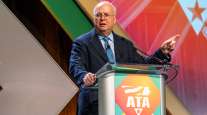Paccar Adds Drive Axles, Single-Unit Aftertreatment

In three consecutive Oct. 1 press conferences at ATA’s Management Conference & Exhibition, Paccar also announced improvements to the MX-11 and MX-13 engines, many of which power the company’s Kenworth and Peterbilt trucks.
In addition, the two operating companies said at the annual meeting of American Trucking Associations that they are still undecided about how they will approach 2017 North American truck shows and the choice between the venerable Mid-America Trucking Show and its new rival, the North American Commercial Vehicles Show.
The improved engines will be available in January when federal limits on greenhouse-gas emissions tighten. For the MX-13, output rises to 510 horsepower and 1,850 pound-feet of torque.
For the MX-11 the new maximums are 430 horsepower and 1,650 pound-feet of torque.
The interval for oil and fuel filter changes lengthens to 75,000 miles from 60,000.
Landon Sproull, Paccar vice president for powertrain, said the axles are designed to work with an MX engine and an Eaton Corp. automated manual transmission.
On truck shows, the general managers of the two truck brands gave similar answers.
“We have not firmed up a plan yet. To be announced soon,” Kenworth’s Mike Dozier said of his company's exhibit plans.
“We’ll probably be talking about that in the very near future,” Peterbilt’s Darrin Siver said.
Competitors Daimler Trucks North America, Navistar Inc. and Volvo Group have said separately they will use the new NACV Show as the focus of their 2017 North American marketing efforts, and either downplay or skip Mid-America.
Dozier said Kenworth is adding the Cummins Westport ISL G Near-Zero to its engine lineup during the first quarter of 2017. Using natural gas for fuel, the engine combines low emissions of carbon dioxide and nitrogen oxide compounds.
He said it will be aimed at port trucks, municipal fleets, vocational trucks and California, in general.
Siver said his Model 579 Epiq will be coming out as a day cab in the second quarter of next year, and that he expects 2017 truck sales to be fairly similar to this year’s level.
Concerning the federal Phase 2 GHG rule that will tighten emissions from 2021 to 2017, he said the final rule announced in August was “kind of what we expected.”
Siver said Paccar executives worked the federal authors of the rule.
He was not bothered by the rule’s section on glider kits, even though Peterbilt is a major manufacturer of them.
“The gliders will probably be phased out over the next several years, but we hope those operators will buy a new Peterbilt instead, so we’re OK,” Siver said.




